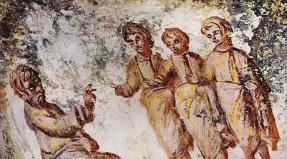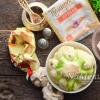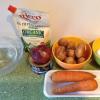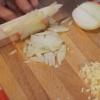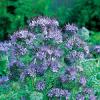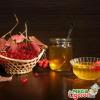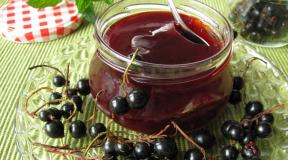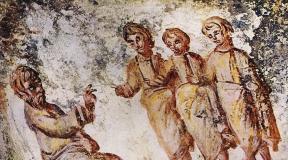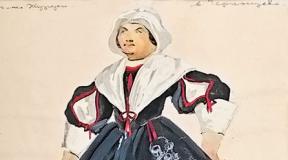Black currant. Black currant Fruits of black currant in Latin
Black currant(lat. Ribes nigrum) is a shrub of the Gooseberry family, capable of reaching a height of 2 meters. Its name comes from the Old Russian word “currant”, meaning a strong smell. It is interesting that black currants have berries, leaves, and branches that smell, while its “relatives” - white and red currants - are practically devoid of aroma.
In addition to their wonderful taste, black currant berries are very healthy: they have a high content of vitamins A, C, PP, essential oils and many microelements, including sodium, magnesium, calcium and iron.
Origin
Compared to other berry crops, currants are quite “young” - they are “only” about 500 years old. Neither the ancient Romans nor the ancient Greeks knew about currants. The shrub with tonic, sour berries was first noticed by Arabs in conquered Spain in the 15th century. The berries and leaves of the bush were used as medicine at that time.
Almost at the same time, black currant became known in Rus', where it was called the “stinking bush,” that is, odorous. Just like in Europe, currants were used in folk medicine, as well as in preparing vegetables for the winter.
The nutritional value
Black currant is a storehouse of useful substances: it contains organic acids (citric and malic), sugars (glucose and fructose), tannins and pectin substances, essential oil, and flavonoids. Among the vitamins contained in the berry (B, P, C, K, PP, provitamin A - carotene), especially noteworthy is vitamin C, of which black currant contains up to 400 mg per 100 g of weight. To meet the daily requirement for this vitamin, it is enough to eat only 20-30 berries. It is worth keeping in mind that already 2 weeks after the currant fruits are fully ripe, the loss of vitamin C in them can reach 70%.
The mineral composition of black currant berries is rich in elements such as sodium (32 mg per 100 g of weight), calcium (36 mg), potassium (372 mg), magnesium (35 mg), phosphorus (33 mg) and iron (1.3 mg). ).
Use in cooking
Currant berries are good both fresh and processed. All kinds of syrups, jellies, juices are prepared from them, jams, jelly and pastilles are made, as well as original sauces for fried or baked meat. Blackcurrant tinctures, wines and liqueurs are tasty and tart. Fragrant berries are often included in yoghurts; they are used for fillings in sweets, pies and other baked goods.
Blackcurrant leaves are also used in cooking. They are added as a spice when pickling mushrooms and vegetables, for preparing sugar-lowering dietary salads, and added to tea and sauces.
Application in medicine and cosmetology
The leaves and fruits of black currant have a disinfectant effect, and also have diaphoretic, diuretic and fixative properties. Blackcurrant can prevent vision problems, the development of diabetes, and is an excellent remedy for the prevention of Alzheimer's disease and problems with the cardiovascular system. This berry is especially useful for progressive atherosclerosis, as well as for diseases of the kidneys, liver and respiratory tract. Currant juice in reasonable doses helps increase hemoglobin in the blood.
Black currant is often included in creams and lotions that smooth and tone the skin. In addition, puree from these berries can be used to strengthen nails by rubbing it into the skin around the nail and into the nail plate itself. Currants also help get rid of freckles, age spots and make your skin lighter.
Contraindications
Due to the high content of vitamin K and phenolic compounds, black currants are contraindicated for thrombophlebitis. People suffering from stomach and duodenal ulcers and gastritis should not eat the berry either. After suffering a heart attack or stroke, you should not drink currant juice. This drink can also cause an allergic reaction in children and people prone to allergies. Some experts also believe that during pregnancy it is better to avoid using currant juice for medicinal purposes.
Currant ( Ribes) - a genus of flowering plants of the class Dicotyledons, order Saxifragaceae, family Gooseberry.
The origin of the modern name “currant” has a couple of conflicting versions. According to one of them, the name of the bush comes from the ancient Russian word “smorod”, meaning “stench, bad smell”. According to another version, currants got their “name” from the word “to currant” - which means to emit a pleasant, strong aroma.
The mineral composition of currants is represented by the following components: sodium, calcium, magnesium, copper, sulfur, lead, silver, iron, phosphorus. Also, a high content of coumarins, pectin and iodine was found in currant fruits.
Currant berries have a number of components essential for the human body:
- malic, phosphoric and citric acids;
- essential oils;
- tannins;
- phytoncides;
- anthocyanins.
Due to its beneficial properties, currants are often used to alleviate a number of pathological conditions:
- improvement of hematopoiesis in diseases of the lymphatic and circulatory system;
- normalization of blood pressure in hypertension;
- decreased blood glucose levels in diabetes mellitus;
- restoration of immunity in case of vitamin deficiency and after serious illnesses;
- laxative, diuretic and diaphoretic effects;
- treatment of dermatitis and diathesis;
- rheumatism, gout and polyarthritis;
- gastritis and stomach ulcers;
- bleeding gums;
- increased nervous excitability and sleep disturbances.
The beneficial properties of currants also manifest themselves in decoctions and infusions: decoctions and infusions of currant berries, its leaves, buds and shoots are used to treat skin diseases. The beneficial properties of red currants are mainly concentrated in the fruits, so its juices and fresh berries are used for treatment.

Harm of currants and contraindications
Currants have a number of contraindications and can be harmful if you have the following diseases:
- increased blood clotting;
- peptic ulcer of the stomach and duodenum;
- gastritis with high acidity;
- hepatitis of any kind;
- tendency to constipation;
- there is a history of stroke;
- vein thrombosis;
- allergy to currants.
To properly plant currants you need to know:
- How to choose a place for a seedling,
- What are the timing (time) of planting currants,
- What should be the ideal soil for a plant?
- What should be the distance between currant bushes when planting?
- How to dig a planting hole,
- What fertilizers are needed?
The best place to plant currants is in open areas with maximum light throughout the day. Currants grow well on any permeable, optimally moistened soil, but they prefer chernozem loam.
Planting currant seedlings can be done in early spring, before the buds open, or in the fall, in September, the main thing is to plant the bushes in previously prepared soil. 1-2 weeks before planting, it is necessary to dig planting holes or ditches 35-40 cm deep and apply 5-6 kg of fertilizer under each currant bush: rotted manure or compost, 20-25 g of superphosphate and potassium sulfate, and then mix them well with earth.
The distance between bushes when planting currants should be at least 2-3 meters. On heavy loams, the pits are deepened to 50-60 cm and drainage is arranged at the bottom from a layer of sand, and the fertilizer rate is increased by one and a half times. On the eve of planting, the fertilized holes are spilled with water, and the currant seedlings are shortened, leaving 3-5 buds on each shoot. The seedling is planted vertically, the roots are straightened, covered with soil and watered. The settled soil is trampled down and mulched with peat or straw. It is better not to use sawdust as mulch, because it acidifies the soil and takes nitrogen from it.
For subsequent propagation, the seedling is planted obliquely, deepening the root collar by 10 cm, then additional roots and shoots will grow.

Caring for currants: pruning, fertilizing
Caring for currants does not cause much trouble. During the season, it is necessary to remove weeds and loosen the soil in the root zone. Currants need regular, but not abundant watering, otherwise the plant will immediately shed its leaves during drought.
In early spring or late autumn, blackcurrant bushes need to be rejuvenated by cutting out old branches at the root, removing diseased and low-fruiting shoots. Red currant branches are shortened by 5-6 eyes. The main thing is that no more than 10-15 shoots of different ages remain on one bush.

Fertilizing currants with fertilizers
Caring for currants involves timely feeding of bushes with fertilizers. If currants were planted in well-fertilized soil, you can do without fertilizing for the first 2-3 years. It will be enough for the bushes to incorporate mulch material into the soil in the fall, which is placed in the root zone every spring.
After 2-3 years, during the autumn digging, they begin to apply dry phosphorus-potassium mineral fertilizers at the rate of 30 g per currant bush. Urea and ammonium nitrate are washed out by melt water, so they are applied in early spring - directly on the snow or in dissolved form (20-25 g per bush). During flowering, fertilize with organic fertilizers (mullein 1:10 or bird droppings 1:15). To improve fruit set and improve the quality and size of berries, after flowering, currant bushes are sprayed with the preparation “Ovary” or a solution of zinc sulfate.
Reproduction of currants by cuttings, layering, dividing the bush
There are 3 ways to propagate currants:
- By dividing the bush,
- By cuttings,
- By layering.
Let's look at each of these methods in more detail.
The method of propagating currants by dividing the bush is not used very often. This method is excellent when there is a shortage of planting material or when very valuable varieties are forced to be transplanted from a site to another place. Another advantage of this method of transplanting currants is the rapid rooting of a new bush without any special techniques or manipulations.
The technique is quite simple: in the fall, at the end of September - beginning of October, or in early spring, the desired currant bush is carefully dug out of the ground, trying not to damage the root system. Using pruning shears or a sharp garden file, absolutely all old branches should be cut out, and young branches should be shortened to a height of 25-30 cm. Using a sharp ax, the bush should be divided into 3-4 parts (depending on its size). The main thing is that each part of the plant that you will plant in the future has well-formed buds and sufficiently branched and healthy roots. In a prepared hole, 60-80 cm deep and fertilized with rotted manure, planting material is installed in the center, covered with earth, which is carefully but tightly compacted and watered thoroughly (1-1.5 buckets for each bush).

Propagation of currants by cuttings
This method of propagating currants is considered the most productive when preserving varieties or breeding hybrids, especially when there is not very much initial planting material. Cuttings are carried out in an already prepared substrate, consisting of a mixture of soil, compost and organic fertilizer - rotted manure. Surprisingly, cuttings can be carried out both in spring and autumn (woody shoots are used for this), and in summer, using green currant cuttings. Therefore, there are no specific timings for cuttings.
- Currant cuttings in spring or autumn
One-year-old shoots are taken as lignified cuttings. You need to cut currant cuttings for propagation only from healthy bushes. It is very convenient to do this, combining it with regular pruning of the currant bush. The length of the currant cutting should be within 16-25 cm, the diameter of the cutting should be at least 6 mm. When preparing cuttings, a cut in their upper part is made directly above the bud, retreating upward 1-1.5 cm. In the lower part of the cutting, an oblique cut is made under the bud.

The cuttings are buried obliquely, leaving 2-3 buds above the soil surface. The place where the currant cuttings are planted should be watered abundantly and mulched with a layer of humus or peat. If the cuttings were planted in the spring, then by autumn quite powerful roots will form on them, and the plant can be transplanted to a permanent place. When planting currants in autumn with the onset of cold weather, the cuttings should be covered with spruce branches, fallen leaves or straw to prevent them from freezing. Please note that you need to plant currant cuttings before winter, taking into account the bush’s entry into the dormant phase. For black currants it begins in September-early October, but for red currants it begins at the end of August. It is during these months that it is necessary to start propagating currants.

- Cutting currants in summer
You need to cut green currant cuttings for propagation in the summer; it is better to do this on a cool day. Branches that are just beginning to undergo lignification are suitable for cutting: they should be quite flexible, but break if sharply bent. On a cutting 10-12 cm long, 3-5 leaf blades are left, but on a pair of lower leaves the plate is shortened by half or removed completely, leaving only the petioles. The lower ends of the prepared material are immersed in a solution of any growth substance for a day, after which green currant cuttings are planted in prepared greenhouses or greenhouses, buried 2-3 cm into the ground. The main condition for excellent survival is high humidity in the greenhouse in the first 3 weeks. Plants should be watered regularly and additionally sprayed in hot weather. In about a month, the currant cuttings will give strong roots, then they can be fed with nitrogen fertilizer and watering reduced. Next spring, young bushes are planted from the greenhouse into the soil, and by autumn they will turn into powerful currant bushes.

Black currant- Ribes nigrum L. - is probably familiar to everyone. This is a shrub from the gooseberry family (Grossulariaceae) 1-1.5 (up to 2) m high. Its branches are covered with dark brown bark. The leaves are alternate, petiolate, up to 10 cm in diameter, palmate-lobed, with 3 or 5 sharp lobes, their middle lobe is noticeably larger than the lateral ones, the leaves are dark green above, somewhat lighter below, with pubescence along the veins. On the underside of the leaf blade, yellow glands that secrete essential oil are clearly visible.
The flowers are collected in 5 - 10-flowered drooping racemes. They are broadly bell-shaped, with 5 lilac bent sepals, a reddish corolla of 3 petals, 5 stamens, a pistil with a lower 1-locular ovary. The fruits are multi-seeded black, black-brown or dark purple spherical berries up to 1 cm in diameter. All parts of the plant, especially leaves, flowers and fruits, have a characteristic pleasant odor. It blooms in May-June and is pollinated by insects, mainly honey bees. Spring frosts often damage the buds, thereby reducing the berry yield. The fruits ripen in July-August; in wild plants they quickly fall off (often the lower berries in the cluster fall off while the upper ones are still green).
Black currant is widespread as a wild plant in the forest and forest-steppe zones of the European part of Russia, the Urals and Siberia, as well as in the adjacent countries of Eurasia. It grows in fairly moist habitats: along the banks of rivers, streams and lakes, in shady ravines, along the edges of swamps, in floodplain black alder forests, willow trees and other damp forests. It reproduces well vegetatively: by root suckers, by dividing the bush, by rooting branches bent to the soil.
Introduced into cultivation as a berry plant in the Middle Ages. Domestication appears to have taken place in different locations throughout the species' extensive range. There is reliable evidence that in Rus' this shrub was cultivated already in the 11th century, while for Western Europe information about the culture of black currant dates back only to the 15th - 16th centuries. Now black currant is one of the most common berry crops in both industrial and amateur gardens. It is grown a lot in France, where excellent liqueurs are made from it, as well as in England and Germany.
Economic use of black currant
Black currant is an important food and medicinal plant. Its berries contain up to 13% sugars (mainly glucose and fructose), 1.5-3% acids (citric, malic, tartaric, etc.), up to 1% pectin, tannins and coloring substances, potassium, sodium, calcium salts, magnesium, iron, manganese, phosphorus, which determines their high taste and nutritional benefits.
Black currant is one of the most valuable vitamin-containing plants of the Russian flora. It is especially rich in ascorbic acid (vitamin C) - the berries of some varieties accumulate from 1.4 to 4% of this vital compound (wild forms up to 0.4%). In terms of vitamin C concentration, currant fruits are superior to lemons, oranges and other citrus fruits and are second only to such recognized vitamin-rich fruits as rose hips and actinidia. In addition to vitamin C, fruits contain a significant amount of vitamins B and P, as well as provitamin A (carotene). Blackcurrant berries are eaten fresh, the juice is squeezed out of them, jam is made, a paste is made from fresh fruits with granulated sugar (vitamins are most fully preserved in such a product, which is not subject to heat), and processed into wine, soft drinks, and various confectionery products.
In Rus', currant leaves have long been brewed instead of tea. They are used to flavor various pickles made from vegetables and fruits. At the same time, in addition to improving the taste, the product is somewhat enriched with vitamins. Black currant is a good honey plant.
Medicinal value of black currant and methods of medicinal use
Blackcurrant has a number of general high nutritional and healing properties. The fruits and leaves of black currant contain a large amount of vitamin C, and the absence of enzymes in them that destroy ascorbic acid creates conditions for long-term storage of the berries, which even when frozen completely retain this essential vitamin, especially in winter and early spring.
In folk medicine, black currant berries and leaves are used in the treatment of diabetes, decreased appetite, chronic gastritis, enterocolitis, anemia, liver diseases, nose and internal bleeding, and also as an antiemetic. Blackcurrant leaves have good diuretic and anti-inflammatory properties. They are often used in the treatment and prevention of gout, osteochondrosis, rheumatism, muscle and joint pain, exudative diathesis, eczema, furunculosis, dermatitis, kidney stones, cystitis, urethritis.
Infusion of leaves. 3 - 5 g of leaves per 250 ml of boiling water, simmer Yumin., take 2 - 3 times a day, 0.5 cups for diseases of the kidneys, bladder, urolithiasis. Take hot instead of tea for skin diseases, scrofula.
Currant leaves, infused in white wine and slightly sweetened, are taken before meals as a tonic. Tea made from dry currant and mint leaves. Pour one teaspoon of dry crushed blackcurrant leaves and a pinch of mint into a glass of boiling water and leave for 5 minutes. Drink with honey.
Pour one tablespoon of dry leaves (20 g) into 1 glass of boiling water, leave for 15-20 minutes, take 0.5-1 glass 3-4 times a day before meals for diabetes.
Dry black currant berries are taken according to the same scheme, only they need to be boiled over low heat for 20-30 minutes. or boil for 15 minutes. and leave for 1 - 2 hours. The decoction is used 0.5 -1 glass 3 - 4 times a day before meals to treat anemia.
Currant leaves in the form of a 5% infusion of 500 ml per day are used as a good diuretic and antirheumatic agent.
For rheumatism, the following effective mixture is used.
Currant leaves - 100 g, ash leaves - 500 g, lilac inflorescences - 50 g; Brew 6 - 8 g of this mixture with 180 - 200 ml of boiling water, leave for 15 minutes. Take before meals. The resulting aromatic infusion also has a good effect on digestion.
Berries and currant juice are recommended for increased capillary fragility and hemorrhagic diathesis; they are prescribed to weakened and convalescent patients. Fresh juice is used for gastritis with low acidity, achylia, enterocolitis, bronchitis. Fresh juice - 2 - 3 glasses 3 times a day.
Pour one or two tablespoons of fruit with 1 glass of boiling water and leave for 15 minutes. Take 1/2 - 1 glass several times a day, like tea.
Blackcurrant juice and sugar syrup are used to treat throat diseases, hoarseness, and whooping cough.
Blackcurrant juice, diluted in half with boiled water, is used as a gargle for chronic tonsillitis, sore throat, laryngitis, and pharyngitis. The juice is drunk for a dry hacking cough. It is believed that it is very useful for people who are constantly involved in recitation (teachers, lecturers, actors, etc.) and especially professional singing.
For diphtheria, take Zraza 50 ml of currant juice per day with a tablespoon of honey, diluted in 200 ml of water.
A decoction of the berries is taken for colds as a diaphoretic. Drink 1 tablespoon 4-5 times a day.
At the first signs of flu, carry out the following treatment: finely break blackcurrant branches and brew a full handful of them in 800 ml of water. Boil for 5 minutes and then leave in a thermos for 4 hours. Drink 400 ml of decoction with sugar in bed warm at night. Carry out this treatment twice.
Fresh berries (200-250g) are used in the treatment of hypertension. Free people consume 80-100 g of fresh blackcurrant berries every day before meals.
In summer, black currant berries are pureed with sugar (per 1 kg of berries - 1.5 kg of sugar) and used instead of jam.
Dry blackcurrant fruits are included in vitamin preparations.
Rose hips and currants - equally divided. Brew one tablespoon of the mixture with 2 cups of boiling water, leave for at least 1 hour. in a well-sealed container, strain through cheesecloth, add sugar to taste. Take 1/2 cup of Zraz per day.
Rose hips, raspberries, lingonberries, currants in equal parts. Brew two tablespoons of the mixture with a glass of boiling water, boil for 10 minutes, leave in a tightly sealed container. After cooling, strain through cheesecloth and add sugar to taste. Drink 1/2 glass 2 times a day.
The shelf life of dry berries is up to 2 years. Blackcurrant berries, both fresh and dry, as well as ground with sugar, are taken in the same cases as the leaves.
In the absence of berries and leaves, some people use blackcurrant buds.
In Chinese and Tibetan medicine, currants are used for tuberculosis of the lymphatic system.
To prevent hypovitaminosis and as a general tonic in winter and especially early spring, currant tea is very useful. It is done extremely simply. Two teaspoons of crushed dry currants are poured into a glass of boiling water and left for an hour. Drink this infusion half a glass 3-4 times a day.
Juice from the berries is used to moisten the face to remove freckles.
Buds and young leaves in the form of tea - as a blood purifier.
Small children suffering from scrofula (diathesis) and rickets are bathed in a decoction of currant leaves.
Black currant contains the powers of Mercury, Jupiter, Mars, Saturn. Collect during the second phase of the Moon, near the full moon, around noon.
Botanical characteristics
Black currant is a medicinal plant that is widely used in folk and traditional medicine. Many useful products are obtained from it.
Currant (lat. Ríbes nígrum) belongs to the Currant genus and the Gooseberry family. The shrub reaches a height of two meters, has erect, branched stems, red-brown or dark-brown in color. The leaves have a characteristic pleasant aroma, petiolate. They have from three to five blades. The edges of the leaves are serrate, their apex is bare. There are golden glands on the bottom of the leaves.
When crushed, the leaves release a characteristic aroma. The arrangement of the leaves is regular. The flowers of the plant are small in size and have reddish petals. The fruits are black berries, rich in juice, with a characteristic odor. Flowering begins in the last month of spring or early summer, and fruits appear around July.
Taxonomy
Black currant belongs to the Currant genus, which includes more than 100 species. It is found in America, Eurasia, and North-West Africa.

Geography of the plant
Currants, growing in natural conditions, are found everywhere in the European part of Russia; the shrub is also found in Southern Siberia, in the east it reaches Lake Baikal. It grows in places rich in moisture: in forests, on the banks of streams and rivers. There are cases when the plant forms extensive thickets in river valleys. Currant is the mother of a large number of cultivated species. The plant is grown mainly in the north and central Russia.
Compound
- Ascorbic acid - about 400 mg. This component is important for growth and restoration of cellular balance, helps the development of tissues, blood vessels, teeth and bones. The substance helps protect the body from infections, accelerates the patient’s recovery, and stimulates the launch of immune processes. The compound is an antioxidant that accelerates the healing process of wounds and helps synthesize a number of hormones. It removes toxins and improves bile secretion.
- Sugar - up to 17%.
- Vitamin B5. Berries contain this component, which is directly responsible for immunity and resistance to allergic manifestations. This vitamin is necessary for the healthy development of hair and skin. By the way, excess vitamin is never deposited in the body, which is why there is no overdose.
- Other acids - 4.5%. This is a common group of compounds. Their main function is participation in the digestion process. Substances improve microflora, take part in the functioning of the gastrointestinal tract, stimulate juice secretion in the intestines, and protect the body from the development of gastrointestinal diseases. The components have anti-inflammatory, antimicrobial effects, have detoxifying properties,
- 1% proteins. These are complex organic compounds that serve as material for building cells, tissues and even organs. Substances stimulate the immune system, protect the body from infections, participate in the process of absorption of fat, vitamins, and so on.
- Pectins - up to 0.8%. It is a natural polysaccharide. The substance normalizes intestinal motility, maintains bacteriological balance in the human body, and removes toxins from the body.
- Glycosides. This is a large group of organic substances. The components transport sugar in the body, take part in redox reactions, and remove toxins from the body.
- Essential oils, etc. The substances have antiseptic, bactericidal and anti-inflammatory effects, and take an active part in the self-regulation of the body. The components have a positive effect on the scalp, nervous system and restore the beauty of the skin and hair.
Useful components are also contained in other fragments of the plant, in leaves, flowers, and buds. The leaves, for example, contain insoluble organic substances of the aromatic series, rutin, polysaccharides, ascorbic acid, mineral salts, etc. Twenty grams of currant berries can satisfy the body's daily need for vitamin C. In dry summers, the content of ascorbic acid in fruits decreases by an average of 25%. During rainy season it increases. Currants growing in the northern regions contain a lot of the above-mentioned acid.
Beneficial properties of black currant:
This wonderful plant is replete with beneficial properties. Among them are diaphoretic, diuretic, and fixative. The leaves, fruits, and buds of this shrub have found their use as a disinfectant component. This property is due to the presence of essential oil.
Herbal products prepared from leaves help fight dysentery bacillus. In early spring, when the body feels an urgent need for vitamins, the leaves will serve as their source. Harvested plant buds can be used in winter as vitamin supplements.

Qualities of currant leaves:
The beneficial properties of the leaves of the shrub help to obtain general strengthening and antiseptic drugs. They contain biologically active substances and vitamins.
It is often used for gout and gastritis, as well as all kinds of cardiovascular ailments. For ophthalmological diseases, traditional healers also advise consuming currants.
Currants and cooking:
Currant is a berry known to every housewife. Naturally, it has found its application in the kitchen. Delicious drinks and jam are prepared from the berries. The hostess knows a lot of recipes involving currants. Excellent fruit drinks are also obtained from it, pleasant to the taste and extremely healthy. Berries are included in cakes, casseroles, pies and other sweets.
Currants are used in a very unusual way - they make sauces for fish and meat dishes.
Use of black currant in folk medicine:
The use of currants is widespread among traditional healers, as well as in homeopathy. The berries and leaves are used in the treatment of gout, urolithiasis, gastritis, rheumatism, bronchitis, and anemia. Tinctures from berries are used to treat diseases of the genitourinary system.
The tincture of the leaves is recommended for use in the treatment of edema, colds, and scrofula. It is also recommended for rheumatism, cystitis, etc. Berry tincture can also be consumed as a drink containing beneficial vitamins.
In pediatrics, currants are used for baths in the treatment of diathesis and rickets. The syrup is used to rinse the mouth for colds.
The beneficial properties of jam made from the berries of the plant pureed with sugar are known. In winter, such a delicacy is an excellent source of vitamins. The plant also contains pectins, which remove toxins and tidy up the intestinal microflora, and also help improve digestion.
Berry decoction helps relieve constipation, stops inflammatory processes in the bladder, and helps add vitamins to your diet.
To prepare a medicinal potion, use this recipe: add up to five large spoons of frozen, dried or fresh fruits to a small saucepan. Pour boiling water into it and cook it all for several minutes. The drink must brew, this will take a couple of hours. Drink three times a day for two weeks. The norm is half a glass.
The medicinal properties of black currant make it possible to prepare a healing infusion, which is famous for its general strengthening properties. Use this recipe: chop a dozen leaves, as well as a couple of twigs of the plant. Take two large spoons of the resulting mass and pour boiling water (500 ml). The decoction should steep (about 60 minutes), after which it can be drunk half an hour before meals three times a day.
The healing potion, the recipe for which you just received, can be used for the treatment and prevention of various diseases. It also has a general strengthening effect.

Currants and cosmetology:
The amazing beneficial properties of the plant are used in cosmetology. There are many known cosmetic preparations based on this plant, which:
- nourish and moisturize the skin;
- promote epidermal regeneration;
- normalize the functioning of the sweat glands;
- help relieve irritation;
- eliminate age spots;
- promote strengthening of nails and hair;
- nourish the dermis with vitamins;
- stimulate collagen production;
- rejuvenate the skin.
The use of black currant makes it possible to obtain an extract that is the basis for the preparation of lotions and tonics, masks for the body, face and hair.
The plant is also used for making cosmetics in artisanal conditions. Masks are prepared from currants, as well as delicious lotions that have healing properties.
- Berry juice has a whitening property, so in the summer it is recommended to wipe the skin with a cotton swab dipped in the juice.
- The juice is frozen in the refrigerator, after which it is used for an invigorating massage.
- The juice of unripe berries helps whiten the skin. The product is mixed with table vinegar and stirred until it becomes milky in color. You can wipe your face with the finished herbal product twice a day.
Plant research
To date, the medicinal properties of black currant have not been fully studied. The study of this plant is a promising direction of science. Preparations containing currant extract are being studied. They help treat high eye pressure.
In Japan, the effect of plant anthocyanins on the vision of people with glaucoma was studied. The experiment was carried out over two years. Patients received mainly drops. Useful components were taken in a dosage of 50 milligrams once a day for two years. Those receiving the beneficial components had improved vision and ocular blood flow. The authors of the experiment recognized black currant as an excellent additive component to the main therapy for people suffering from glaucoma.
In Japan, the effect of blackcurrant components on visual impairment during prolonged contact with a computer monitor was also studied. When using currant extract in three different dosages, a decrease in the dark adaptation threshold was found, in other words, the subjects began to see much better in the dark. The experiment leads to the conclusion that people who consume the berries of the plant and are forced to spend a lot of time working with a computer will retain their vision.
New Zealand conducted its own research on blackcurrant juice. The results showed that the product was able to relieve pain during exercise. 10 athletes took part in the experiment; they were of different ages. People trained for three weeks and took currant extract before and after training. One pill was equivalent to 28 grams of berries. The experiment showed that over time, the athletes showed significantly less muscle damage and signs of oxidation. Scientists believe that this is all due to the presence of flavonoids in the composition.
In Siberia, scientists studied the chemical composition of blackcurrant berries during its processing and how technology affects the final indicators.
Currently, an urgent task for some institutes is the development of rational processing of fruit and berry raw materials with minimal costs.
Blackcurrant is famous for its unique composition, but during processing a lot of active substances are lost, which is why scientists are trying to find different processing methods in order to preserve the beneficial substances as much as possible.
Scientists came to the conclusion during the study that the berries contain water-soluble and alcohol-soluble compounds that have antioxidant activity, therefore, in the process of processing berries, it is always necessary to take into account the characteristics of the chemical composition and use the right type of solvent.
Scientists have found that during the conservation process, the chemical composition of the plant changes, the number of dry soluble substances increases, and this has a positive effect on diffusion when obtaining extracts.
It has been established that the solvent affects the efficiency of extracting biologically active substances, so general recommendations have also been developed on the technology for obtaining natural dyes from the plant.
Contraindications
The use of currants is prohibited for persons suffering from thrombophlebitis. If the acidity of the stomach is high, it is also not recommended to consume products based on this plant.
In Europe, plant bushes grew in the northern regions as far as Kamchatka. The use of currants as a medicinal product was known back in the fifteenth century. In the eighteenth century, currants gained recognition among the British, French and Germans.
Currant is a relative of Gooseberry. The plant is found on all continents of the planet, except Antarctica and Australia. There are already approximately 150 species of this plant.
By the way, the name of the plant was given by the Arabs. They consumed a lot of rhubarb, which they called "ribas". In 711, Spain was conquered by the Arabs, and they were horrified that the country did not have their favorite rhubarb, and without it the food did not seem so tasty. It was then that they paid attention to currants, which had a pleasant sourish taste, reminiscent of rhubarb, and began to call the plant also “ribas”.
In Russia, epics mention a river named after the plant - “Smorodinovka”. Some historians say that it is the “Moscow River”, because it was on its banks that currants grew, which were actively used for food.
Previously, the plant was called the monastery berry, since in almost all monasteries the monks grew currants. The chronicles of Novgorod and Pskov even speak about this.
Many people think that unripe currants are a completely unhealthy product, but in reality everything is different. Unripe berries contain 4 times more vitamins, which protect the human body from illnesses and strengthen the immune system.
Not only the berries of currants are useful, but also the leaves. In Ancient Rus', people even prepared dried leaves. The leaves contain a lot of vitamins that are useful for the development of the body. In winter, the body lacks vitamins, which is why people in Ancient Rus' dried leaves to compensate for the lack of nutrients.
Currants are an unusually useful product that cures many ailments. You can order currant extracts right now. Don't put it off until later.
see alsoPhoto of the medicinal plant Black currant
Black currant - beneficial properties and contraindications
Black currant- a folk preventive remedy for colds, a remedy for acute and chronic diarrhea, fermentative dyspepsia, diaphoretic, diuretic.
Latin name: Ribes nigrum.
English name: Black current.
Family: Gooseberries - Grossulariaceae.
Common names: alpine berry, gout berry.
Pharmacy name: black currant fruits - Ribis nigri fructus, black currant leaves - Ribis nigri folium.
Blackcurrant parts used: ripe fruits and leaves.
Botanical description: the bush is 1-2 m in height, in contrast to the gooseberry, completely devoid of thorns. The three- to five-lobed leaves have coarsely serrated edges and bear oil glands on the underside. The flowers are arranged in pendulous racemes, yellowish-green, with brownish-red edges. From them, first brown-black, later black fruits develop. The plant has a peculiar smell, quite unpleasant (in Russian, the word “currant” is etymologically related to the verb “currant” to emit a stench, currant, stench). Black currant blooms from April to May.
Habitat: It is believed that the homeland of black currant is Central Europe and Asia. In the wild, it is usually found in damp wooded areas and marshy alder forests.
Collection and preparation: Blackcurrant leaves are harvested in June. Take only leaf blades that are not affected by fungi: black currants are often affected by rust. Drying is done in air. Blackcurrant fruits are harvested when fully ripe. They are most often processed into juice, which should be bottled without additives and sterilized. It can also be used to make a well-preserving jelly with sugar.
Active ingredients: Black currant berries contain vitamins (vitamins C (up to 400 mg/%), B, P, provitamin A), organic acids (citric and malic), various sugars (mainly glucose and fructose), glycosides and flavonoids, pectic, tannic , anthocyanin (cyanidin, delphinidin) and nitrogenous substances. Mineral composition of berries (in mg/%): sodium - 32, potassium - 372, calcium - 36, magnesium - 35, phosphorus - 33, iron - 1.3.
Black currant leaves are rich in ascorbic acid, carotene, phytoncides, and essential oils.
Photo of the juice of the medicinal plant Black currant
Nutritional value table for 100 grams of black currants
100 grams of European blackcurrant contains 1.40 grams of protein, 15.38 grams of carbohydrates, 0.41 grams of fat, calorie content = 63 kcal.
Vitamins:
- - 230 IU
- - 0.050 mg
- - 0.050 mg
- - 0.300 mg
- - 0.398 mg
- - 0.066 mg
- - 181.0 mg
- - 1.00 mg
- And other vitamins in black currants, but with lower content.
Macro- and microelements:
- - 1.54 mg
- - 322 mg
- - 55 mg
- - 24 mg
- - 0.256 mg
- - 0.086 mg
- - 2 mg
- - 59 mg
- - 0.27 mg
- And other macro-microelements in black currant, but with lower content.
Black currant - beneficial properties and uses
Currants have diaphoretic, diuretic and fixative properties. The leaves, buds and fruits of black currant have a disinfectant effect associated with essential oils.
It was not possible to achieve the use of leaves in official medicine, although it was established that they have a dehydrating effect and have an auxiliary effect on rheumatism and gout; attacks of pain after a course of treatment with tea from the leaves become less frequent and easier.
- Recipe for making blackcurrant herbal tea: 1-2 teaspoons with the top of blackcurrant leaves are poured into 1/4 liter of cold water, slowly heated to a boil and immediately filtered. 2-3 cups per day - dosage for edema, urinary retention and rheumatism.
Black currant fruits, especially unsweetened juice prepared from them, are often and successfully given for coughs and hoarseness, as a prophylactic against colds and, above all, as a remedy for acute and chronic diarrhea, especially fermentative dyspepsia, characterized by an extremely unpleasant odor. In all these cases, blackcurrant juice is given several times a day in doses ranging from a teaspoon to a tablespoon. For hoarseness and inflammation in the oral cavity, you can rinse your mouth with juice. To do this, it is diluted with an equal amount of warm water. Finally, dried blackcurrant fruits are sometimes used for diseases of the urinary system. Many sweetened fruit products are also useful - sweet wort, marmalade, jelly. Anyone who loves the taste of blackcurrant and is not afraid of relatively high prices will do well to consume it diligently.
Black currant in folk medicine
Everything that was said above about the use of black currant applies equally to traditional medicine. The leaves are used widely and successfully; rheumatism, gout, dropsy and, above all, whooping cough - these are the diseases for which they are used. Of course, juice is also extremely beneficial for health. It is used as a preventative against colds and as a tonic for loss of appetite and gastrointestinal diseases.
Recipes for making blackcurrant infusions
- IN as a source of vitamins Black currant berries are eaten in any form. For the same purpose, they drink an infusion of plant leaves like tea: 3-5 g of dry raw materials are scalded with 1 glass of boiling water, infused for 10-20 minutes and filtered. The dosage rate is 1/2-1 glass 2-3 times a day.
- At malignant neoplasms fresh and dry blackcurrant fruits are eaten without restrictions. An infusion of plant leaves is also used, 1/2-1 glass 2-3 times a day.
- At allergic diathesis An infusion of black currant leaves is used as a lotion. It is prepared as follows: 5 tablespoons of dry crushed raw materials are infused in 1 liter of boiling water for 20 minutes, then filtered. For the same disease, take this infusion 1/2-1 glass orally 4-5 times a day.
- At urolithiasis for therapeutic and prophylactic purposes in the preoperative period, when the type of stones is unknown, it is useful to eat fresh and dry blackcurrant fruits, as well as take 1/2-1 glass 2-3 times a day of the infusion of plant leaves.
- At inflammation of the mucous membrane of the urethra, cystitis, inflammation of the kidneys, pyelonephritis Infusion of black currant leaves is taken 1/2-1 glass 4-5 times a day.
- As diuretic Infusion of dried blackcurrant fruits is drunk 1/2-1 glass several times a day.
- For relieve cough It is useful to eat black currant berries in unlimited quantities; in addition, you can drink an infusion of the fruit 1/2-1 glass several times a day or juice mixed with honey. Infusion of black currant leaves rinse your mouth for stomatitis.
- At pain in the intestines and stomach, dysbacteriosis, vomiting, enterocolitis, constipation, hemorrhoids an infusion of black currant fruit is shown. For this purpose, 20 g of dry raw materials are infused for 15 minutes in 1 glass of boiling water. Take 1/2-1 glass strained 4-5 times a day. In these cases, drink an infusion of plant leaves 1/2-1 glass 4-5 times a day.
- At anemia and exhaustion infusion of black currant leaves is drunk as tea, 1/2-1 glass 2-3 times a day.
- At hemorrhagic diathesis It is recommended to take 2-1 glasses of infusion of black currant leaves 4-5 times a day. It is prepared as follows: 1 tablespoon of dry crushed raw materials is infused for 20 minutes in 1 glass of boiling water.
- At hypertension and atherosclerosis It is useful to take an infusion of black currant leaves 1/2-1 glass 2-3 times a day.
- For removal of mercury, lead, cobalt, tin from the body, binding and removal of radioactive elements A decoction of dried blackcurrant fruits is recommended. For this purpose, 20 g of raw material is poured into 1 glass of hot water, boiled for 15 minutes, filtered, squeezed and the volume of liquid is brought to the original volume with boiled water. Take 1/2 glass per day.
ATTENTION!
Self-medication is dangerous! Before treating at home, consult your doctor.
Treatment with currants
- Avitaminosis. Add 750 g of mashed blackcurrant fruits to 0.5 kg of sugar. Take 1 tbsp. spoon after meals 3 times a day. The course of treatment is 1 month.
- Acne(acne). 1 tbsp. pour a spoonful of dry crushed blackcurrant leaves with 1 cup of boiling water and keep on low heat for 5-10 minutes. Then let the broth brew, and strain after 2-3 hours. Drink the entire prepared broth throughout the day without any restrictions.
- Liver and gallbladder diseases(acute and chronic forms). Brew young shoots of black currant and drink as tea.
- Gastritis. Eat blackcurrant fruits and juice.
- Gastritis(low acidity). Drink a third of a glass of juice 5 times a day 20-25 minutes before meals.
- Gastritis(with secretory insufficiency). Drink 50-70 ml of currant juice before meals 3 times a day.
- Flu. Brew 50 g of chopped black currant branches with 4 glasses of water. Boil for 5 minutes, leave for 4 hours. Drink the infusion warm in bed at night, 2 glasses with sugar (for diabetes, sweeten with stevia). Carry out this treatment twice.
- Bladder diseases. Infusion recipe: 1 tbsp. Brew a spoonful of leaves with 2 cups of boiling water, leave for 6 hours, strain. Drink 1/2 glass 4 times a day.
- Joint diseases. Aches in the joints go away if you drink an infusion of fresh blackcurrant leaves instead of tea. This infusion dissolves uric acid crystals.
- Blood poisoning. Brew blackcurrant buds and drink as tea.
- Skin diseases. Blackcurrant juice - 20 ml, rendered lard - 80 g. Mix thoroughly. Lubricate sore areas with ointment and wash with calendula decoction.
- Skin diseases. 1 tbsp. Pour a spoonful of black currant leaves with 2 cups of boiling water, leave for 6 hours, strain. Drink half a glass 4 times a day.
- Urolithiasis disease. 20 berries (fresh or dried), pour 2-3 cups of boiling water, preferably in a thermos, leave for 8 hours and take 1 tbsp warm. spoon 5-6 times a day, regardless of meals.
- Urolithiasis disease. 1 tbsp. Brew a spoonful of blackcurrant leaves with 2 cups of boiling water, leave for 6 hours, strain. Drink half a glass of infusion 4 times a day.
- Heart rhythm disturbance. Drink blackcurrant juice with pulp, one-third of a glass, 3 times a day, regardless of meals.
- Runny nose. Brew 50 g of finely chopped currant branches with 4 cups of boiling water. Boil for 5 minutes, leave for 4 hours. Drink the infusion warm in bed at night, 2 glasses with sugar. Carry out the treatment twice.
- Acute colitis. Blackcurrant juice: take 100-150 ml 3 times a day.
- Blood purification. Pour 1 teaspoon of dried currant buds with 1 glass of hot milk, leave for 15 minutes, strain. Drink 1 glass of infusion 2 times a day.
- Cleansing blood vessels. Every day for 3 months before going to bed, consume 2-3 tablespoons of black currant (juice, fresh or frozen berries).
- Rheumatism. 1 tbsp. Brew a spoonful of blackcurrant leaves with 2 cups of boiling water, leave for 6 hours, strain. Drink 1/2 glass 4 times a day.
- Rheumatism, gout. 3-4 leaves and a currant sprig 15 cm long or 10-12 leaves pour 0.5 liters of boiling water, leave, cool and drink the infusion half a glass 4-6 times a day.
- Adrenal cortex stimulation. 2 tbsp. spoons of chopped thin stems and leaves of black currant pour 2 cups of boiling water, cool and drink a third of a glass 5-6 times a day 30-40 minutes after meals.
- Tuberculosis of the lymph nodes. 3 tbsp. spoons of crushed currant leaves pour 0.5 liters of boiling water, leave for 2 hours, strain and drink a third or half a glass 4 times a day. The treatment is long-term.
- Scurvy. Eat black currant berries and drink a decoction of them.
- Stomach and duodenal ulcers. Drink blackcurrant juice 150-200 ml per day.
Side effects. Unknown.
Contraindications. Black currant is contraindicated for stomach and duodenal ulcers with high acidity of gastric juice. Not recommended for increased blood clotting, thrombophlebitis, as well as in the post-infarction and post-stroke period.

